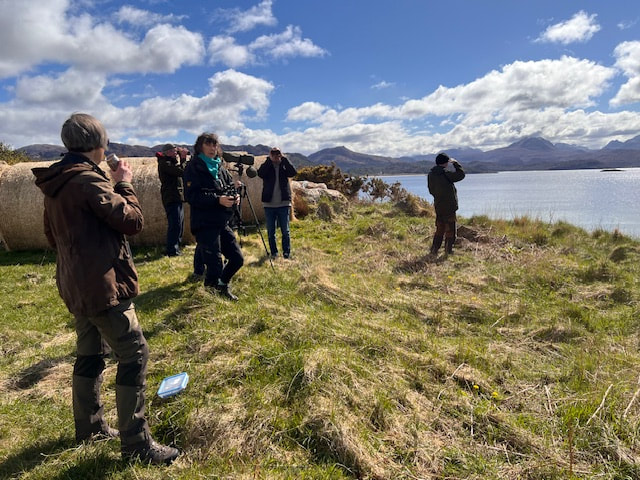The east coast party of eight met at Tore school cum community hall at 8.15 and set off in three cars. The count started immediately, thus inflating the list total with a few species, Rook, Carrion Crow, Jackdaw, Red Kite, that might not be encountered further west. The highlights on brief stops en route were Osprey, on the usual nest at Lochluichart, Song Thrush, volubly advertising its presence at Achnasheen, Red-throated Diver, on one of the lochs on the watershed (and later in the bay at Gairloch harbour), and Long-tailed Tit plus the first of at least three Cuckoos for the day, at the visitor centre on Loch Maree.
By the time the Old Inn at Gairloch harbour was reached, the two east coast campervanners and the west coast contingent of three had been assembled for some time; long enough to hear various spring migrants, including a Grasshopper Warbler, singing in the welcome bright sunshine. It was now over to the three locals to show us the sights; Tracy to lead us on the best woodland and coastal walks, Peter to point out the most likely spots to find certain species and Alan to provide a historical background to some of the buildings and estates. A pleasant circuit from the Old Inn provided a variety of woodland habitat, where Willow Warbler, Chiffchaff, Blackcap, Bullfinch, Great Spotted Woodpecker and, surprisingly for the time of day, a Tawny Owl were heard.
By the time the Old Inn at Gairloch harbour was reached, the two east coast campervanners and the west coast contingent of three had been assembled for some time; long enough to hear various spring migrants, including a Grasshopper Warbler, singing in the welcome bright sunshine. It was now over to the three locals to show us the sights; Tracy to lead us on the best woodland and coastal walks, Peter to point out the most likely spots to find certain species and Alan to provide a historical background to some of the buildings and estates. A pleasant circuit from the Old Inn provided a variety of woodland habitat, where Willow Warbler, Chiffchaff, Blackcap, Bullfinch, Great Spotted Woodpecker and, surprisingly for the time of day, a Tawny Owl were heard.
Seawatching on the road to Melvaig (Sue Seright)
Ruadha Reidh lighthouse (Mary Galloway)
The entourage, now all in cars, proceeded along the coastal road to Melvaig and Rubha Reidh, which provided several good vantage points to scan for Turnstone, Oystercatcher, Merganser, Common Scoter and Great Northern Diver. On land, there were nice sightings of Stonechat, Linnet, Wheatear, Golden Plover and, for those in the lead car, an altercation between a Buzzard and a White-tailed Eagle; for those in the rear cars, the only display was a triumphant twirl from the Buzzard. Peter also gave a fascinating account of a major new herring spawning ground on a three-mile long, corrugated shelf just offshore, further north than any previously known sites. The volume of spawn (from an unimaginably large congregation of adult herrings) had provided a frenzied feeding bonanza for many species of seabird and other marine predators, but also demonstrated the vulnerability of herring stocks to ocean-bed trawling for scallops on this special area of seabed.
The convoy was reduced by one car (as Alan had to leave for duties in the Gairloch museum in the afternoon) by the time lighthouse hove into view. Our arrival was welcomed by a Raven and, more important, by Sue who lives there and was very helpful in ensuring we had enough parking space among the various visiting tradesmen’s vans present. This was probably the highlight of the trip, having lunch in the warm sunshine, sheltered from the keen NE wind behind the perimeter wall, and watching the seabirds bob up and down in the swell or flash past along the rocky shore. Black Guillemot, Lesser Black-backed Gull, Kittiwake and Rock Dove were lazing around just offshore, but you had to have your eye on the ball to spot the four Whimbrel and a Gannet as they flashed past.
The convoy was reduced by one car (as Alan had to leave for duties in the Gairloch museum in the afternoon) by the time lighthouse hove into view. Our arrival was welcomed by a Raven and, more important, by Sue who lives there and was very helpful in ensuring we had enough parking space among the various visiting tradesmen’s vans present. This was probably the highlight of the trip, having lunch in the warm sunshine, sheltered from the keen NE wind behind the perimeter wall, and watching the seabirds bob up and down in the swell or flash past along the rocky shore. Black Guillemot, Lesser Black-backed Gull, Kittiwake and Rock Dove were lazing around just offshore, but you had to have your eye on the ball to spot the four Whimbrel and a Gannet as they flashed past.
The group birdwatching ended at Poolewe, where the foreshore was thoroughly searched by telescope from two vantage points. With focussed concentration, Greenshank, Ringed Plover, Goosander and Bar-tailed Godwit slowly emerged from the background jumble of rock and seaweed. A loop through the mixed woodland on the other side of the road produced Crossbill, Goldcrest and Greenfinch, but what lit up the observers’ imagination as much as anything was the strange little orange fungus, Bog Beacon (Mitrula paludosa), encountered by the path. Afterwards, with many thanks to Tracy and Peter, the parties went their separate ways home. Two cars chose the scenic route north past Aultbea, Gruinard and Dundonnell before striking eastwards. A Black-throated Diver was then noted on one of the lochans, just in time before the visibility was obscured by some surprisingly heavy showers. This brought the species total for the trip to 79.
Bog Beacon at Poolewe (Sue Seright)


 RSS Feed
RSS Feed
